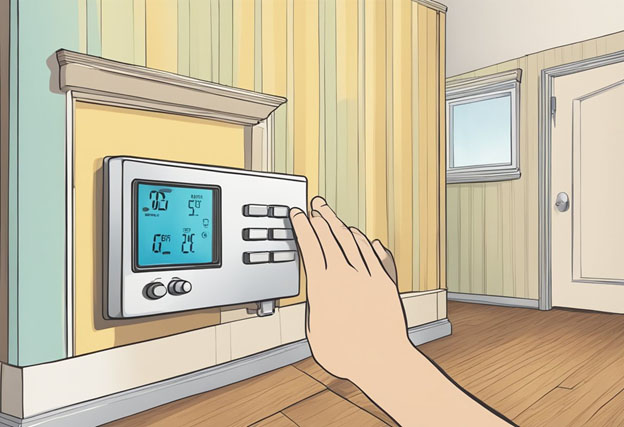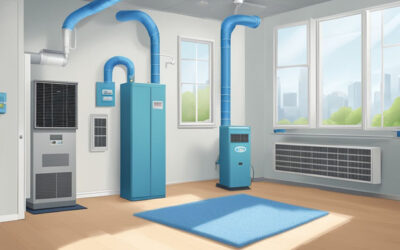Thermostats play a crucial role in maintaining the temperature of your home. They help to regulate the heating and cooling system, and ultimately determine how comfortable your living space is. However, when it comes to deciding whether to adjust or turn off the thermostat when you’re away, many homeowners are left wondering which strategy is best.
There are a few factors to consider when deciding on a thermostat strategy. One of the main factors is energy efficiency. Turning off the thermostat completely while you’re away may seem like the most energy-efficient option, but it can actually lead to increased energy consumption and higher bills. Adjusting the thermostat to a slightly higher or lower temperature, on the other hand, can help to save energy and money.
Another important factor to consider is the impact on your HVAC system. Constantly turning the thermostat on and off can put extra strain on the system, leading to increased wear and tear and potentially costly repairs. Adjusting the thermostat, rather than turning it off completely, can help to maintain a more consistent temperature and reduce the strain on your HVAC system.
Understanding Thermostats
Types of Thermostats
There are several types of thermostats available in the market, and each one has its unique features. Some of the most common types of thermostats include:
- Mechanical Thermostats: These thermostats use a bimetallic strip that expands or contracts based on the temperature. As the strip expands, it causes a switch to turn on or off the heating or cooling system.
- Digital Thermostats: These thermostats have a digital display that shows the current temperature and allows users to set the desired temperature using buttons.
- Programmable Thermostats: These thermostats allow users to set different temperatures for different times of the day. For instance, users can set the thermostat to turn on the heating system before they wake up in the morning and turn it off when they leave for work.
- Smart Thermostats: These thermostats are connected to the internet and can be controlled using a smartphone app. They can learn users’ preferences and adjust the temperature accordingly.
How Thermostats Work
Thermostats work by sensing the temperature in the room and turning the heating or cooling system on or off to maintain the desired temperature. When the temperature drops below the set temperature, the thermostat turns on the heating system, and when the temperature rises above the set temperature, it turns off the heating system.
Thermostats can be set to different temperatures depending on the time of day or the user’s preferences. Some thermostats can also be set to turn off the heating or cooling system when no one is home to save energy.
Overall, understanding the different types of thermostats and how they work is essential for homeowners to choose the right one for their needs and to use it efficiently.
Benefits of Adjusting Your Thermostat
Adjusting your thermostat is a simple and effective way to save energy and extend the lifespan of your HVAC system. By making small changes to the temperature settings when you’re away from home, you can enjoy significant benefits in terms of energy savings and reduced wear and tear on your system.
Energy Savings
One of the primary benefits of adjusting your thermostat is the potential for energy savings. By setting your thermostat a few degrees higher in the summer or lower in the winter when you’re away from home, you can reduce the amount of energy your HVAC system uses to maintain a comfortable temperature. This can result in lower energy bills and a reduced carbon footprint.
Extended HVAC Lifespan
Another benefit of adjusting your thermostat is the potential to extend the lifespan of your HVAC system. By reducing the workload on your system when you’re away from home, you can reduce the wear and tear on its components. This can help to prevent breakdowns and extend the overall lifespan of your system, saving you money on repairs and replacements in the long run.
Overall, adjusting your thermostat is a simple and effective way to save energy and extend the lifespan of your HVAC system. By making small changes to your temperature settings when you’re away from home, you can enjoy significant benefits in terms of energy savings and reduced wear and tear on your system.
Strategies for Adjusting Thermostats
Adjusting the thermostat is an effective way to save energy and reduce utility bills. By setting the thermostat to a higher temperature when you’re away, you can reduce the amount of energy your HVAC system uses to cool or heat your home. Here are two strategies for adjusting thermostats:
Programmable Thermostats Settings
Programmable thermostats allow homeowners to set different temperatures for different times of the day. By programming the thermostat to a higher temperature when you’re away, you can save energy and reduce your utility bills. For example, you can set the thermostat to 78°F when you’re at work and 72°F when you’re at home. This way, the air conditioner won’t have to work as hard to cool your home during the day.
To get the most out of your programmable thermostat, you should set it up properly. You should program the thermostat to match your daily routine. For example, if you work from 9 am to 5 pm, you should set the thermostat to 78°F from 8 am to 9 am and from 5 pm to 10 pm. You should also program the thermostat to adjust the temperature gradually. This will prevent the HVAC system from working too hard to cool or heat your home.
Smart Thermostats and Geofencing
Smart thermostats are another way to adjust your thermostat when you’re away. Smart thermostats use geofencing to detect when you’re away from home. Geofencing is a technology that uses GPS to create a virtual boundary around your home. When you leave the boundary, the thermostat will automatically adjust the temperature to save energy.
Smart thermostats can also learn your daily routine and adjust the temperature accordingly. For example, if you usually come home at 6 pm, the thermostat will start cooling your home at 5:30 pm. This way, your home will be cool when you arrive.
In conclusion, adjusting your thermostat is an effective way to save energy and reduce your utility bills. Whether you have a programmable thermostat or a smart thermostat, you can use these strategies to save money and reduce your carbon footprint.
Turning Off Your Thermostat: Pros and Cons
Potential Energy Savings
Turning off your thermostat when you’re away from home can result in significant energy savings. By not heating or cooling your home unnecessarily, you can reduce your energy consumption and lower your utility bills. According to the U.S. Department of Energy, you can save up to 10% per year on heating and cooling costs by turning your thermostat back 7-10 degrees Fahrenheit for 8 hours a day.
Risks and Considerations
However, turning off your thermostat completely can also have some downsides. For example, if you live in a particularly humid or hot climate, turning off your air conditioning completely can lead to mold growth or heat damage to your home. Additionally, if you have pets or plants that require a certain temperature range, turning off your thermostat can be harmful to them.
Another consideration is the time it takes to heat or cool your home when you return. If you turn off your thermostat completely, it may take longer to reach a comfortable temperature when you get home. This can be particularly uncomfortable during extreme weather conditions.
Overall, turning off your thermostat can be an effective way to save energy and reduce your utility bills. However, it’s important to consider the potential risks and downsides before making a decision. If you’re unsure, consider adjusting your thermostat instead of turning it off completely. This can still result in energy savings while ensuring your home remains at a safe and comfortable temperature.
Comparing Strategies: Adjusting vs. Turning Off
Comfort Levels
When it comes to comfort levels, adjusting the thermostat is the better strategy. Turning off the thermostat completely can result in a stuffy and uncomfortable indoor environment, especially during the summer months. On the other hand, adjusting the thermostat by a few degrees can help maintain a comfortable temperature while also saving energy.
Cost-Efficiency Analysis
In terms of cost-efficiency, turning off the thermostat is the better strategy. By turning off the thermostat, homeowners can save money on their energy bills. However, this strategy is only effective if the homeowner is away for an extended period of time. If the homeowner is only away for a few hours, adjusting the thermostat by a few degrees is a more cost-effective strategy.
To further illustrate the cost-efficiency of these strategies, consider the following example. Let’s say a homeowner has a programmable thermostat and is away for 8 hours a day, 5 days a week. If the homeowner turns off the thermostat completely during those 8 hours, they can save approximately $180 per year. However, if the homeowner adjusts the thermostat by 5 degrees during those 8 hours, they can still save approximately $60 per year.
Overall, both strategies have their advantages and disadvantages. Homeowners should consider their personal preferences, lifestyle, and energy usage when deciding which strategy to use. By making a conscious effort to adjust or turn off the thermostat when away, homeowners can save money on their energy bills while also reducing their carbon footprint.
Best Practices for Thermostat Use When Away
When it comes to saving energy and money on your heating and cooling bills, adjusting or turning off your thermostat when you’re away from home can make a big difference. Here are some best practices for using your thermostat when you’re away:
Seasonal Considerations
In the winter, it’s generally recommended to keep your thermostat set to at least 55°F to prevent pipes from freezing. However, if you’ll be away for an extended period of time, you can set it lower to save energy. Just be sure to raise the temperature a few degrees before you return to prevent the house from feeling too cold.
In the summer, you can set your thermostat to a higher temperature (such as 85°F) when you’re away to save energy. Just be sure to lower it a few degrees before you return to prevent the house from feeling too hot.
Vacation Mode Features
Many thermostats come with vacation mode features that can help you save energy when you’re away for an extended period of time. These features usually allow you to set a specific temperature range for your home while you’re away, and some even allow you to control your thermostat remotely through a smartphone app.
If your thermostat doesn’t have a vacation mode feature, you can still save energy by manually adjusting the temperature before you leave and when you return. Just be sure to give your home enough time to reach a comfortable temperature before you return.
By following these best practices, you can save energy and money on your heating and cooling bills without sacrificing comfort.
Innovations in Thermostat Technology
Learning Thermostats
Learning thermostats are a recent innovation in thermostat technology that have gained popularity in recent years. These thermostats are designed to learn the habits and preferences of the occupants of a home and adjust the temperature accordingly. They use advanced algorithms to analyze patterns in temperature and occupancy data, and can even learn to anticipate when a home will be occupied based on historical data.
One of the benefits of learning thermostats is that they can help save energy by automatically adjusting the temperature when no one is home. They can also be controlled remotely using a smartphone app, which allows users to adjust the temperature from anywhere.
Remote Temperature Control
Remote temperature control is another innovation in thermostat technology that has become increasingly popular in recent years. This feature allows users to control the temperature of their home from anywhere using a smartphone app or web interface.
Remote temperature control can be especially useful for people who travel frequently or have irregular schedules. It allows them to adjust the temperature of their home before they arrive, ensuring that the home is comfortable when they get there.
Many new thermostats come with remote temperature control as a standard feature, and some older thermostats can be retrofitted with a remote control module. This feature is also available on many smart home systems, which allow users to control not just their thermostat, but also other connected devices in their home.
Overall, these innovations in thermostat technology are making it easier than ever for people to control the temperature of their homes and save energy in the process.
Implementing Effective Thermostat Strategies
When it comes to implementing effective thermostat strategies, there are a few key factors to consider. By following these tips, you can ensure that your home stays comfortable while also saving energy and money.
Setting Up a Schedule
One of the most effective ways to use your thermostat is to set up a schedule. This involves programming your thermostat to automatically adjust the temperature at certain times of the day. For example, you could set the temperature to be cooler during the day when nobody is home, and warmer in the evening when everyone is home.
To set up a schedule, you will need to consult your thermostat’s manual or contact a professional for assistance. Once you have programmed your schedule, you can sit back and let your thermostat do the work.
Utilizing Thermostat Apps
Another way to optimize your thermostat’s performance is to utilize thermostat apps. Many modern thermostats come with companion apps that allow you to control your thermostat from your smartphone or tablet.
By using a thermostat app, you can adjust the temperature from anywhere, at any time. This means that you can turn the heat up before you get home from work, or turn it down if you forget to do so before leaving for a vacation.
In addition, some thermostat apps offer advanced features such as energy usage tracking and personalized recommendations for saving energy. By taking advantage of these features, you can further optimize your thermostat’s performance and save even more money on your energy bills.
Overall, implementing effective thermostat strategies is key to keeping your home comfortable while also saving energy and money. By setting up a schedule and utilizing thermostat apps, you can take control of your home’s temperature and optimize your energy usage.





0 Comments